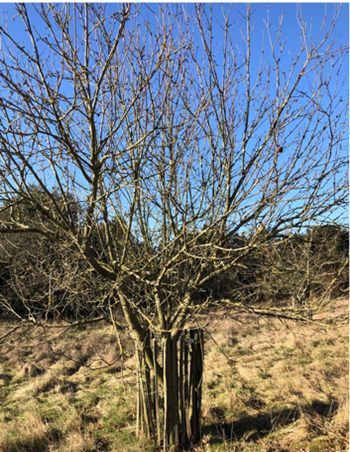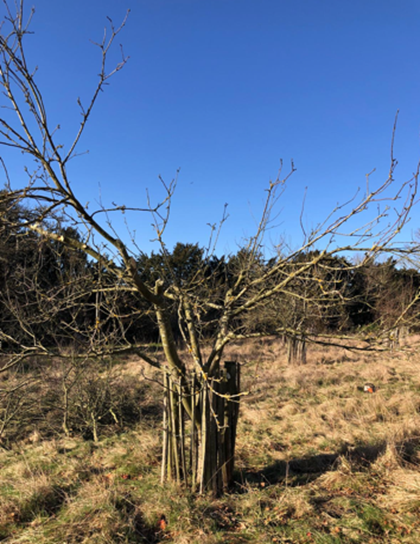Farming in Protected Landscapes Case Study:
Bevills Farm Orchard Restoration

This 19th Century orchard lost most of its trees in the 1987 hurricane. The Estate replaced the lost trees with rare pre-1900 fruit trees but these had become very over-grown.
Bevills have been given a grant of £29,954 in 2023-24 and £6,828 to restore these unique trees, and to record and name the varieties using specialist advice.
Why is this work needed?
Traditional orchards were once a characteristic feature of the farmed landscape, usually alongside the farm house. Modern commercial orchards typically replace the trees regularly, so the benefits of ancient trees to wildlife don’t exist. Bevills’ orchard is a scarce survivor of an historic traditional orchard in the same location since at least the late C19.
There is a wide range of fruit trees in this orchard including rare varieties of apple, pear, cherry, plum, greengage, meddlar, quince and cobnut. Information on the varieties wasn’t recorded when they were planted, and there has been minimal restorative pruning on the veteran trees nor formative pruning on the now established trees over the past 30 years.
Work on the veteran trees is now urgently needed to promote their resilience to high winds that are increasingly frequent occurrences, and to shape the younger trees so that they can mature. The risk is that these trees may be lost to the landscape if work in not undertaken to protect them.
Traditional orchards are a specialist priority habitat and creating a diversity of age structure through the orchard is essential for associated specialist invertebrates that may be present. They are an important pollen and nectar resource for farmland wildlife as well as for a range of specialist invertebrates that may be associated with this priority habitat such as the noble chafer beetle and ladybirds which provide food sources for birds such as tits, finches and thrushes . Fallen fruits are an important food resource for
birds such as fieldfare and redwing. New fruit tree plantings will provide further nectaring & fallen fruit resources.
What work was done?
Local retiring top fruit grower Angus Scobie provided an oversight of all aspects of the project. He undertook pruning of the veteran trees and oversaw pruning of the other trees. Angus prioritised trees for management and guided pruning activity and gave advise on choice of traditional varieties for planting and appropriate rootstocks.
Top pruning the trees involved equipment to access the branches. 217 trees were pruned in all, with help from the landowner so that the work could be completed before the bird nesting season began.


This St Edmunds Russett is shown before and after pruning in the winter sunshine. All the trees are now numbered and identified, as far as possible. This example was raised by Richard Harvey at Bury St. Edmunds, Suffolk. It received a First Class Certificate from the Royal Horticultural Society in 1875. A sweet, juicy and rich russet apple, which when really ripe has an almost pear like quality.
Over summer 2024, the farmer will review the re-growth of the trees and monitoring their progress to see what further actions is needed. A public right of way follows the eastern boundary of the orchard, so walkers will be able to see the trees is blossom and fruit over the years.
